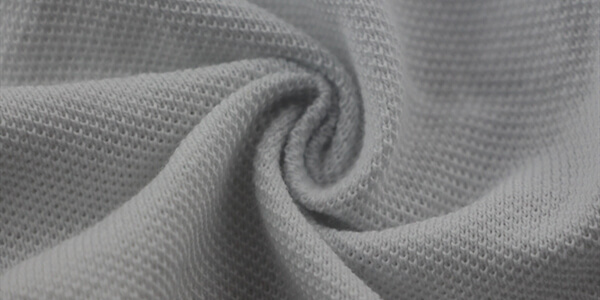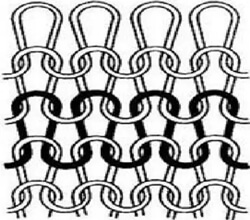
Exploring the Various Styles of Knit Textiles
Knitting is a form of yarn manipulation in which loops are intermeshed to create fabric or textiles. This type of fabric consists of horizontal rows known as courses and vertical rows referred to as wales. Knitted fabrics are used in various everyday items, from clothing to bedding.
The process of knitting requires careful manipulation of yarn loops. To create the fabric, one must pull consecutive loops through a previous row's loop. This intermeshing action forms a series of connected loops that produce the knitted material.
Knitted fabrics are famous for clothing, blankets, and other items that require warmth or flexibility. Knitting is just one type of fabric structure; woven, non-woven, and braided fabrics are also standard. Each has its distinct look and feel, advantages, and disadvantages. The type of fabric you select depends on what you're creating and desired result. Knowing the different kinds of materials available can help you make an informed decision.
1. Weft knitted fabrics
Weft knitted fabrics are usually composed of various raw materials, such as cotton yarn, blended yarn, low elasticity polyester silk or particular shape polyester silk, nylon silk, cotton yarn, wool yarn, and spandex silk. These materials are woven using various methods, including plain stitch organization (containing basic knit, change plain stitch, plain rib weave, and double rib plain weave), jacquard organization, and wool circle organization. Elasticity, softness, wrinkle resistance, and hair type texture are standard features of weft-knitted fabrics. Cotton weft knitted fabric has good moisture absorption and air permeability; however, the material is not crisp and is prone to wrinkling and loosening. On the other hand, chemical fiber knitted fabric is more likely to get fuzz, pilling, or hook silk.

The main categories of weft-knitted fabrics are as follows:
Polyester knitted fabric
This fabric suits men's, women's, and children's clothing. It is a highly wear-resistant and elastic material with great visual appeal. It has a compact and thick structure, making it ideal for jackets, suits, sportswear, yoga clothing, outdoor clothing, windbreakers, vests, skirts, and other garments. The fabric features bright colors and crisp textures that resemble the tweed styles of wool fabric. Color coordination is harmonious, and weave details are clear and distinct.
Knitted cotton fabric
A popular choice in many types of clothing and accessories. It can be found in garments like T-shirts, underwear, casual wear, jackets, suits, trench coats, and even children's clothing. This type of fabric is known for its smooth texture and plump feel. It also has good elasticity and the ability to retain warmth. Popular types of knitted cotton fabric include plain cloth, sweat cloth, mercerized cotton, hoodie cloth, air layer, Roman cloth, and double-sided cloth. These fabrics are of excellent quality, making them ideal for various clothing items.
Polyester cover cotton knitted fabric
The fabric, crafted from a polyester and cotton blend, is ideal for creating shirts, jackets, and activewear. Its wrinkle-resistant fibers make it incredibly easy to care for, and its wear-resistant composition allows for long-lasting use. It's also highly breathable, making it comfortable when worn against the skin. Additionally, it's soft to the touch, making it an excellent choice for garments. The fabric is also dyed in an array of colors and hues.
Recycled cellulose fiber fabrics
They are a popular choice for clothing and include Tencel fabric, Modal fabric, bamboo fiber fabric, viscose fabric, and copper ammonia fabric. These fabrics are soft, with good heat retention properties and high luster. Knitted garments like t-shirts, underwear, leggings, and skirts are often made from these fabrics. Their lightweight yet durable qualities make them an excellent option for everyday wear. Various materials allow designers to create unique looks to suit any style or occasion. Recycled cellulose fiber fabrics can be easily washed and maintained to keep garments looking new for years to come. These fabrics can provide a luxurious look and feel with the proper care. They are also more environmentally friendly than traditional fabrics, making them an increasingly popular choice for fashion-conscious consumers.
2.Warp knitted fabrics
Warp-knitted fabrics are generally made from synthetic filament materials like polyester, nylon, vinylon, and polypropylene. Alternatively, they may be constructed with natural fibers like cotton, wool, silk, or hemp blended with chemical fibers. This type of fabric provides good longitudinal stability, a crisp feel, and less dispersion. Air permeability is also good, but its lateral extension, elasticity, and softness are weaker than weft-knitted fabrics.
Warp-knitted fabrics are highly durable and ideal for technical and medical textiles, protective clothing, and automotive interiors. Warp knitting has many practical applications in the textile industry due to its unique characteristics. It is commonly used to make lingerie, socks, decorative ribbons, trimmings, swimwear, and upholstery. It is also used as a reinforcement in rubber products such as tires and hoses.
Warp knitting is much faster than weft knitting because it does not require reinserting the yarn into the knitted fabric. This means shorter production times and cost savings for manufacturers, making warp knitting a popular choice for large-scale production. The materials can also be manipulated to create complex patterns with more control than other types of knitting. Warp knitting has become essential in many industries, and technological advancements continue to lead to new possibilities.
The main categories of warp-knitted fabrics are as follows:
Polyester warp-knitted fabric
A popular choice for apparel due to its flat texture and bright colors. It usually comes in two weights; thin and thick. Light polyester warp-knitted fabrics are often used for making shirts and skirts, while medium and thick materials can be used for other garments such as jackets, coats, suits, trousers, and more.
Warp knitted pile fabric.
This fabric is commonly used to produce winter garments such as men's and women's coats, trench coats, jackets, and trousers. It has a pleasing drape, is easy to wash, dries quickly, and can be ironed. However, it is prone to static accumulation and can easily attract dust.
Furthermore, when used with other fabrics such as wool or acrylic, its static property increases, attracting more dust. To reduce this, special anti-static finishes can be applied to the fabric. This helps protect it from dirt and dust, making the material more durable and easier to clean.
In conclusion, warp-knitted pile fabric is ideal for winter garments due to its superior drape, easy washing, quick drying, and ironing ability. It should be noted that it is susceptible to static and dust accumulation and therefore requires special anti-static finishing or other treatments to reduce this.
Warp-knitted mesh fabric
Mesh fabric with a thin texture and excellent elasticity features a soft, soft touch. It also boasts excellent air permeability, ideal for summer apparel like men's and women's shirts. Its versatile nature makes it a popular choice among fashion designers and consumers.
Warp-knitted velvet fabric
The surface of warp-knitted velvet fabric is thick and plush, making it incredibly soft. Its elasticity and heat-retention capabilities make it an ideal choice for winter clothing and children's apparel. It is a luxurious material that provides warmth, comfort, and class. Its thick pile adds a pleasing texture to any garment. Thus, it is becoming increasingly popular for its versatility and elegance. Whether you're looking for a cozy winter coat or an elegant party dress, this fabric will make a statement. Its sumptuous texture and luxurious feel make it the perfect choice for any occasion.
Warp knitted loop fabric.
This fabric has a complete and thick consistency, thanks to its solid yet supple cloth body. It is elastic, absorbs moisture well, and provides good warmth. It is characterized by a stable loop structure and superior wearability and is mainly used for sportswear, lapel T-shirts, pajamas, and children's clothing. Its versatility makes it a popular choice for many apparel applications.
Knitted fabrics are made from various materials, including natural fibers like cotton, hemp, silk, and wool, and synthetic fibers like acrylic, polyester, and spandex. Such fabrics feature good elasticity, moisture absorption, warmth, and comfort. They have a wide variety of patterns, colors, and textures. Knitted fabrics can be classified according to weaving, dyeing, finishing, and other processing methods. Each type of fabric has its unique characteristics. Thus, knitted materials can be used for various types of apparel for men, women, and children.

